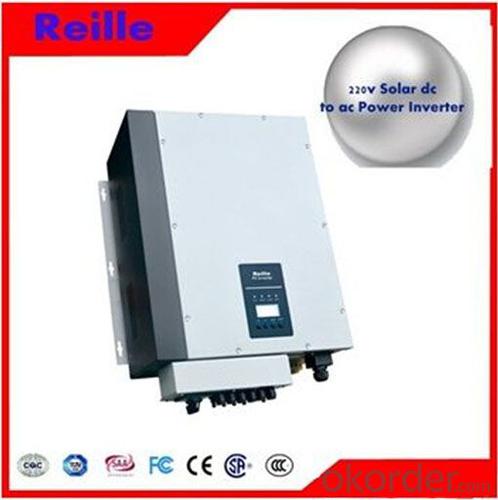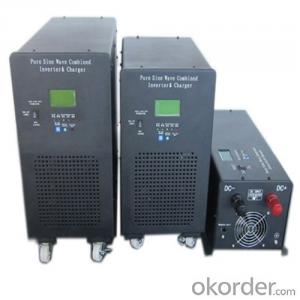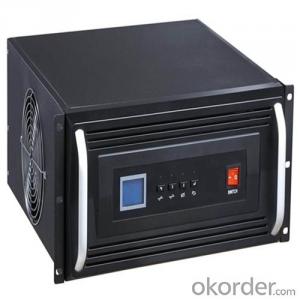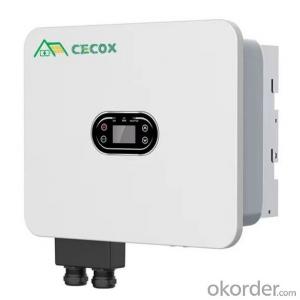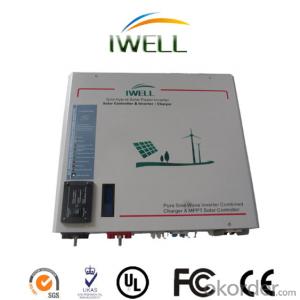Rv Solar Inverter Kit with Charger/Hybrid Solar Inverter/Single Phase Inverter (Pass CE, ISO Certificate)
- Loading Port:
- China main port
- Payment Terms:
- TT or LC
- Min Order Qty:
- 150000 watt
- Supply Capability:
- 3000000 watt/month
OKorder Service Pledge
OKorder Financial Service
You Might Also Like
1. Structure of Power Inverter with Charger/Hybrid Solar Inverter/Single Phase Inverter
(Pass CE,ISO certificate) Description
A solar inverter, or PV inverter, or Solar converter, converts the variable direct current (DC) output of a photovoltaic (PV) solar panel into a
utility frequency alternating current (AC) that can be fed into a commercial electrical grid or used by a local, off-grid electrical network. It is a
critical BOS–component in a photovoltaic system, allowing the use of ordinary AC-powered equipment. Solar inverters have special
functions adapted for use with photovoltaic arrays, including maximum power point tracking and anti-islanding protection.
2. Main Features of Power Inverter with Charger/Hybrid Solar Inverter/Single Phase
Inverter (Pass CE,ISO certificate)
• High MPPT accurac>99.9%
• Wide input voltage range
3. Power Inverter with Charger/Hybrid Solar Inverter/Single Phase Inverter (Pass
CE,ISO certificate) Images
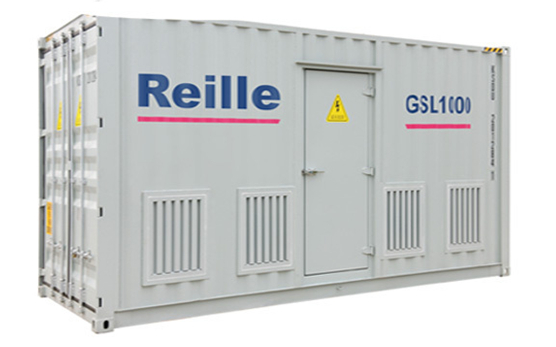
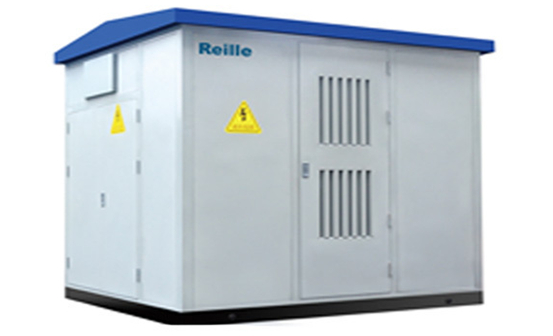
4. FAQ of Power Inverter with Charger/Hybrid Solar Inverter/Single Phase Inverter
(Pass CE,ISO certificate)
Q1:Can we visit your factory?
A1:Sure,welcome at any time,seeing is believing.
Q2:Which payment terms can you accept?
A2:T/T,L/C,Moneygram,Paypal are available for us.
- Q: What is the impact of temperature on the performance of a solar inverter?
- Temperature has a significant impact on the performance of a solar inverter. As temperature increases, the efficiency of the inverter tends to decrease. This is primarily due to the fact that high temperatures can lead to increased resistive losses within the inverter's components, resulting in reduced overall efficiency. Additionally, excessive heat can cause the inverter to experience thermal stress, leading to potential malfunctions or even failures. Therefore, it is crucial to consider temperature management and cooling measures to optimize the performance and lifespan of a solar inverter.
- Q: Can a solar inverter be used in a ground-mounted solar tracking system?
- Yes, a solar inverter can be used in a ground-mounted solar tracking system. In fact, the solar inverter is an essential component of the system as it converts the DC electricity generated by the solar panels into AC electricity that can be used to power appliances and be fed into the grid. The solar inverter's functionality remains the same whether it is used in a ground-mounted solar tracking system or a fixed tilt system.
- Q: Can a solar inverter be used with a solar tracker system?
- Yes, a solar inverter can be used with a solar tracker system. In fact, using a solar inverter with a solar tracker system can enhance the overall efficiency and performance of the system. The solar inverter converts the direct current (DC) generated by the solar panels into alternating current (AC) that can be used to power electrical appliances or be fed into the grid. This AC power can then be easily integrated with the solar tracker system to continuously adjust the position and alignment of the solar panels to maximize their exposure to sunlight. Overall, combining a solar inverter with a solar tracker system can optimize the energy generation and increase the overall output of the solar power system.
- Q: Can a solar inverter be used with solar-powered streetlights?
- Yes, a solar inverter can be used with solar-powered streetlights. A solar inverter is responsible for converting the direct current (DC) produced by solar panels into alternating current (AC) that can be used to power various electrical devices, including streetlights. By integrating a solar inverter into the system, solar-powered streetlights can efficiently utilize the energy captured from the sun to illuminate the streets.
- Q: Can a solar inverter be used for commercial-scale solar installations?
- Yes, a solar inverter can be used for commercial-scale solar installations. In fact, commercial-scale solar installations often require multiple solar inverters to convert the DC power generated by the solar panels into usable AC power for commercial use. These inverters are designed to handle the higher power output and voltage levels typically found in larger solar installations.
- Q: Can a solar inverter be connected to a backup battery system?
- Yes, a solar inverter can be connected to a backup battery system. This allows the excess solar energy generated during the day to be stored in the backup battery system for later use during times when there is no sunlight available, such as at night or during power outages.
- Q: Can a solar inverter be used in regions with high levels of dust or debris?
- Yes, a solar inverter can be used in regions with high levels of dust or debris. However, it is important to regularly clean and maintain the inverter to ensure optimal performance and prevent any damage caused by the accumulation of dust or debris.
- Q: What is the role of a fault detection system in a solar inverter?
- The role of a fault detection system in a solar inverter is to monitor the performance and health of the inverter and solar panels, and to detect any faults or abnormalities that may occur during operation. It helps to identify issues such as short circuits, voltage fluctuations, overheating, or component failures, which can affect the efficiency and safety of the solar power system. By quickly identifying and alerting the user or system operator about these faults, the fault detection system allows for timely maintenance or repair, ensuring optimal performance and longevity of the solar inverter.
- Q: Can a solar inverter be used with a portable solar panel system?
- Yes, a solar inverter can be used with a portable solar panel system. The solar inverter converts the direct current (DC) generated by the portable solar panels into alternating current (AC) that can be used to power various devices or be fed into the electrical grid. This allows for the efficient utilization of the energy generated by the portable solar panel system.
- Q: Are there any government incentives or rebates available for solar inverters?
- Yes, there are government incentives and rebates available for solar inverters in many countries. These incentives and rebates vary depending on the country and sometimes even on the state or region within a country. It is recommended to check with local government or energy authorities to find out specific incentives and rebates available for solar inverters in your area.
Send your message to us
Rv Solar Inverter Kit with Charger/Hybrid Solar Inverter/Single Phase Inverter (Pass CE, ISO Certificate)
- Loading Port:
- China main port
- Payment Terms:
- TT or LC
- Min Order Qty:
- 150000 watt
- Supply Capability:
- 3000000 watt/month
OKorder Service Pledge
OKorder Financial Service
Similar products
Hot products
Hot Searches
Related keywords


